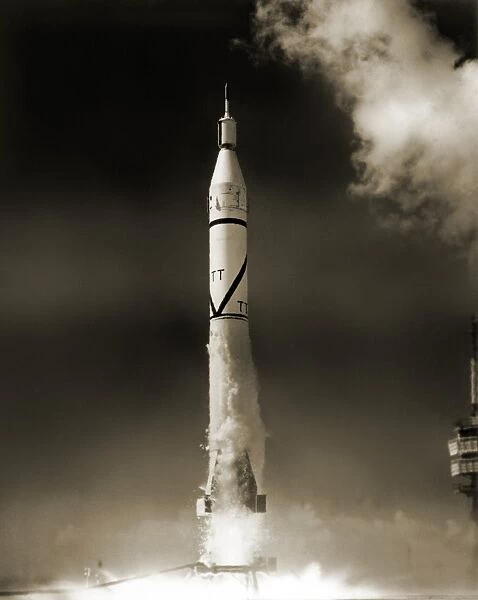Home > Science > Space Exploration > Space Rockets
Explorer 4 launch
![]()

Wall Art and Photo Gifts from Science Photo Library
Explorer 4 launch
Explorer 4 launch. Explorer 4 being launched by a Jupiter-C rocket from Cape Canaveral (now Kennedy Space Centre), Florida, USA, on 26 July 1958. The rocket-shaped satellite, which weighed 25.5 kilograms, was housed in the nose cone of the rocket. It orbited Earth at heights of between 260 kilometres and 2200 kilometres until 23 October 1959. It stopped transmitting on 5 October 1958. It carried instruments, including a geiger counter, to make detailed measurements of charged particles trapped in the Van Allen radiation belt, a torus of charged particles held in place by the Earths magnetic field. The Van Allen radiation belt was discovered by the Explorer 1 satellite launched in January 1958
Science Photo Library features Science and Medical images including photos and illustrations
Media ID 6442215
© NASA/VRS/SCIENCE PHOTO LIBRARY
1900s 1950s Artificial Satellite Blast Off Blasting Off Cape Canaveral Cosmic Ray Research Florida International Geophysical Year Jet Propulsion Laboratory Juno Kennedy Space Centre Launch Launcher Launching Nasa North American Rocket Space Flight Space Race Us A Van Allen Radiation Belt Mono Chrome
EDITORS COMMENTS
This print captures the historic moment of the Explorer 4 launch on July 26,1958. The Jupiter-C rocket propels the rocket-shaped satellite into space from Cape Canaveral, Florida, marking a significant milestone in American space exploration. Weighing 25.5 kilograms, this technological marvel was housed within the nose cone of the rocket. For over a year, Explorer 4 orbited Earth at varying altitudes between 260 and 2200 kilometers until October 23,1959. Equipped with advanced instruments including a geiger counter, it meticulously measured charged particles trapped within Earth's magnetic field known as the Van Allen radiation belt. This discovery was made possible by its predecessor, Explorer 1 satellite launched earlier in January that same year. The image showcases not only an iconic moment but also symbolizes humanity's relentless pursuit of knowledge beyond our planet's boundaries during the Space Race era. As part of cosmic ray research conducted during the International Geophysical Year (IGY), this mission contributed immensely to our understanding of outer space and paved the way for future explorations. Preserved through time, this monochrome photograph serves as a reminder of how far we have come in our quest to unravel the mysteries of our universe. It stands as a testament to human ingenuity and determination while honoring those who played pivotal roles in shaping modern-day space exploration.
MADE IN THE USA
Safe Shipping with 30 Day Money Back Guarantee
FREE PERSONALISATION*
We are proud to offer a range of customisation features including Personalised Captions, Color Filters and Picture Zoom Tools
SECURE PAYMENTS
We happily accept a wide range of payment options so you can pay for the things you need in the way that is most convenient for you
* Options may vary by product and licensing agreement. Zoomed Pictures can be adjusted in the Cart.



